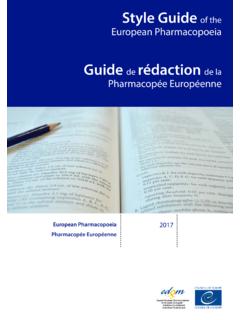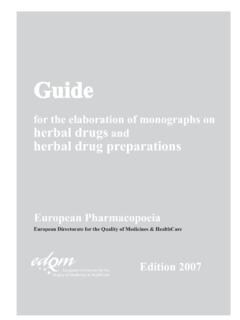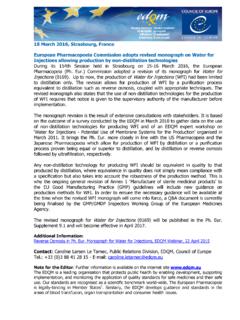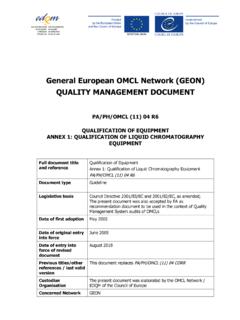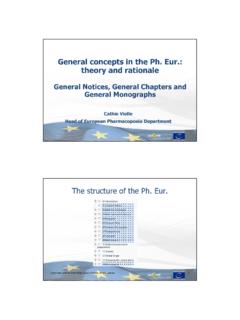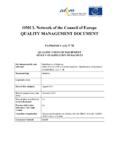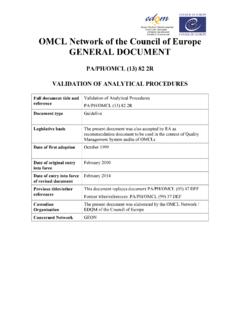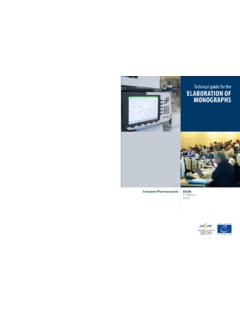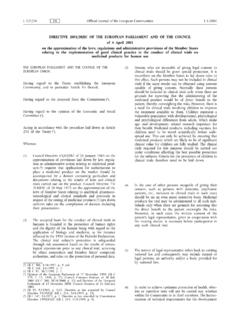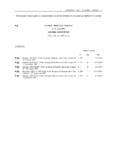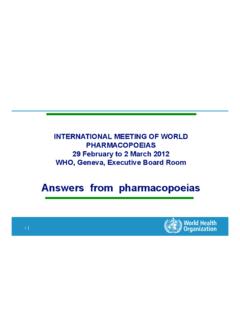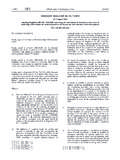Transcription of GOODPRACTICE GUIDELINES - European …
1 1 GOODPRACTICEGUIDELINESFor ImplementingStandardsandSpecificationsfo rthe QualitySysteminBloodEstablishmentsIntrod uctory NoteGoodPracticeGuidelineshavebeenprepar edthrough anad hocco-operationbetweenthe EuropeanDirectoratefor the QualityofMedicines& HealthCare ofthe Councilof Europe(EDQM/CoE)and theCommissionofthe EuropeanUnion (EU).These GoodPracticeGuidelinesare includedinthis 19thEditionof the Guide tothe preparation, use andquality assurance ofbloodcomponents, Appendix toRecommendation No. R (95)15ofthe Committee ofMinisters onthe preparation,use and quality assurance ofblood ,accordingtoDirective2005/62/EC,that thequalitysysteminplaceinallbloodestabli shments complieswiththestandards andspecificationsset toimplementthestandardsandspecifications setoutinthe AnnextoDirective2005/62/EC,itsArticle 2,asamendedbyDirective(EU)2016/1214,isre placedbythefollowing: MemberStatesshall ensurethat, inordertoimplementthestandardsandspecifi cationssetoutintheAnnextothis Directive, therearegoodpracticeguidelinesavailablet oandusedbyallbloodestablishments, intheirqualitysystem,goodpracticeguideli neswhich takefullyintoaccount, where relevantfor bloodestablishments, thedetailedprinciples andguidelines ofgoodmanufacturingpractice, asreferred tointhefirst subparagraphofArticle 47ofDirective 2001/83/EC.
2 Indoingso,MemberStatesshalltakeintoaccou nt theGoodPracticeGuidelinesjointlydevelope dbytheCommissionandtheEuropeanDirectorat e for the Quality ofMedicinesandHealthcareofthe Council ofEuropeandpublished bytheCouncil ofEurope. Councilof EuropeMemberStatesshouldtakethenecessary measuresandstepstoimplementtheGoodPracti ceGuidelinespublishedinthis 19thEdition ofthe Guide tothe preparation,use andqualityassuranceofblood components. These GoodPracticeGuidelinesprovide guidanceonhowtoimplementthestandardsand specificationsofquality systemsthatMemberStatesshall ensure arein place inbloodestablishments and hospital blood blood establishmentsandhospitalbloodbanks1. General General blood establishment must develop and maintain a QualitySystem that is based on EUGood Manufacturing practices (GMP) Directive 2003/94/EC and meets the requirementsidentified in the Directive 2005/62 blood and bloodcomponentsimported from third countries and intended foruse ordistribution in the EU, there must be a Quality System for blood establishments in the stagespreceding importation equivalent to the QualitySystem provided for in Article 2of Directive2005/62 must be recognised as being the responsibilityof all persons involved in the processesofthe bloodestablishment,with management ensuringasystematicapproachtowardsqualit yand the implementation and maintenance of aQuality System (Directive 2005/62/ ).
3 Responsibilityofexecutive participation and commitment both of staff in many different departments and at all levelswithin the organisation and of the organisation s suppliers and distributors. To achieve thisquality objective reliably there must be a comprehensively designed and actor in the supply chain should establish, document, and fully implement acomprehensively designed QualitySystem to deliver Quality Assurance based on theprinciplesof Quality Risk management by incorporating good Practice and Quality basic concepts of Quality Management, good Practice and Quality Risk Management are described here in order to emphasise their relationships andfundamental importance to the preparation of blood and blood Management is a wide-ranging concept covering all matters, which individually orcollectively influence the quality of blood and blood components. It is the sum total of theorganised arrangements made with the objective of ensuring that bloodcomponents are of thequality required for their Management therefore incorporates Quality System encompasses quality management, quality assurance, continuous qualityimprovement, personnel, premises and equipment, documentation, collection, testing andprocessing, storage, distribution, quality control, blood component recall, and external andinternal auditing, contract management, non-conformance and self-inspection (Directive2005/62/EC/Annex ).
4 Quality System must ensure that all critical processes are specified in appropriateinstructions and are carried out in accordance with the standards and specifications of GOODPRACTICE and comply with appropriate regulations as set out in the chapters on Standards in3thisGuide(whichincludestheAnnexto Directive2005/62/EC). QualitySystemmustbedesignedtoassure the qualityandsafetyofpreparedbloodandblood components, as well as ensure donor and staff safety and customer service. This strategyrequires the development of clear policies, objectives and responsibilities. It also requiresimplementation by means of quality planning, quality control, quality assurance and qualityimprovement to ensure the quality and safety of bloodand blood components, and to providecustomer management has the ultimate responsibility to ensure that an effective QualitySystem is in place and resourced adequately, and that roles and responsibilities, are defined,communicated and implemented throughout the organisation.
5 Executive management sleadership and active participation in the Quality System is essential. This leadership shouldensure the support and commitment of staff at all levels and sites within the organisation tothe Quality management should establish a quality policy that describes the overall intentionsand directionof the blood establishment and/or hospital blood bank (hereinafter referredto as organisation ) related to quality. They should also ensure QualitySystem management andGood Practice governance through management review to ensure its continuing suitabilityand Quality System should be defined and Manual or equivalentdocumentshouldbeestablishedand containadescriptionoftheQualitySystem(in cludingmanagement responsibilities). blood establishments and hospital bloodbanks must be supported by a qualityassurancefunction (whetherinternal or related) for fulfilling quality assurance. That function must beinvolvedinall quality-relatedmatters,andmustreviewanda pproveallappropriatequality-related documents (Directive 2005/62/EC/Annex ).
6 Independent function with responsibility for quality assurance must be established. Thisquality assurance function will be responsible for the oversight of all quality processes butneed not necessarily be responsible for carrying out the procedures, premises and equipment that have an influence on the quality and safety ofblood and bloodcomponents must be validated before introduction and must be re-validatedat regular intervals, as determined as a result of these activities (Directive 2005/62/ ). general policy regarding qualification of facilities and equipment as well as validation ofprocesses, automated systems and laboratory tests must be in place. The formal objective ofvalidation is to ensure compliance with the intended use and regulatory formal change controlsystem must be in place to plan, evaluate and document all changesthat mayaffectthe quality,traceability,availabilityoreffec tofcomponents,orthesafetyofcomponents, donors or patients.
7 The potential impact of the proposed change must beevaluated, and the degree of re-validation or additional testing, qualification and validationneeded must be formal system for the handling of deviations and non-conformances must be in place. Anappropriate level of root-cause analysis should be applied during the investigationofdeviations,suspectedprodu ct defects,andother QualityRisk Management principles. If the true root cause(s) of the issue cannot bedetermined, consideration should be given to identifying the most likely root cause(s) and humanerror issuspectedor identifiedasthe cause,thisshouldbejustified having taken care to ensure that process, procedural or system-based errors orproblems have not been overlooked, if present. Appropriate corrective actions and/orpreventive actions(CAPAs)shouldbeidentifiedandtaken inresponse of such actions should be monitored andassessed in accordance with QualityRisk Management must review the system at regular intervals to verify its effectivenessandintroduce corrective measures if deemed necessary (Directive 2005/62/EC/Annex ).
8 Should be periodic management review and monitoring both of its effectiveness, withthe involvement of executive management and of the operation of the QualitySystem toidentify opportunities for continual improvement of blood and blood components processesand the system quality reviews should be conducted with the objective of verifying the consistency ofthe existing process and the appropriateness of current specifications in order to highlighttrends and to identify improvements in both component and product quality review mayalso be considered as an instrument for surveying the overallquality status of a bloodcomponent and its manufacturing processes,including the a review should normally be conducted annually and should be documented. It starting materials; critical in-process controls; results of qualitycontrol and quality monitoring; all changes; qualificationstatusofequipment; technical agreements and contracts; all significant deviations, non-conformances, and the corrective actionsimplemented; the findings of internal and external audits and inspections, and the correctiveactions implemented; complaints and recalls; donor acceptance criteria; donor deferrals; of look-back Practice is the part of QualityManagement that ensures that blood and bloodcomponents are produced and controlledconsistentlyto the qualitystandards appropriate totheir intended use.
9 good Practice is concerned with collection, processing, testing release andstorage (hereinafter included in the generic term preparation ) and qualitycontrol. The basicrequirements processes are defined clearly and reviewedsystematically in the light of experience andshown to be capable of consistentlydelivering blood and blood components of the requiredquality and complying with their strategy includes ensuring ; ; premises and space; equipment and services; materials, containers and labels; procedures and instructions; storage and transport; and procedures are written in an instructional form in clear and unambiguouslanguage, and are applicable specifically to the facilities provided; are trained to carry out procedures correctly; are made, manually and/or by recording instruments, during preparationwhichdemonstrate that all the steps requiredby the definedprocedures and instructions were in facttaken and that the quantityand quality of the blood or blood component was as expected; significant deviations are fully recorded and investigated.
10 (includingdistribution)that enablethe complete historyofthe bloodor blood component to be traced are retained in a comprehensible and accessible form; distribution of the blood and blood components minimises any risk to their quality; torecallanybloodorbloodcomponent (includingthosepreparedusingabatch ofcriticalmaterialsthat havebeendistributedorissued); about blood and bloodcomponents areexamined, the causes of quality defectsinvestigated, and appropriate measures taken in respect of the defective bloodcomponents partofGoodPracticethatisconcernedwith sampling,specificationsand testing, as well as with the organisation, documentation and release procedures whichensure that materials are not released for use in preparation, and blood and blood componentsare not released for distribution, until their quality hasbeen judged to be satisfactory and thatthe necessary and relevant tests have been basic requirements facilities, trained personnel and approved procedures are available for sampling,inspecting/testing starting materials, packaging materials, intermediate components, andfinished blood and blood components and,if appropriate, for monitoring environmentalconditions.
